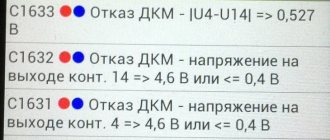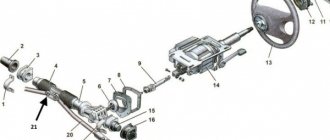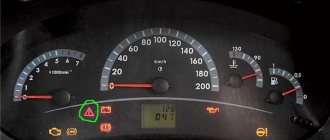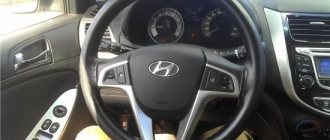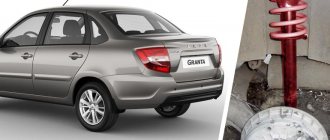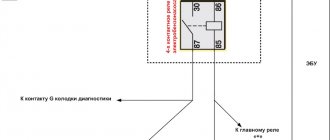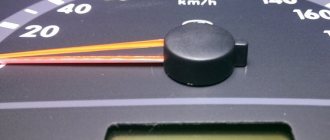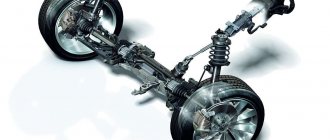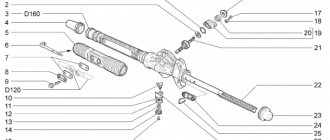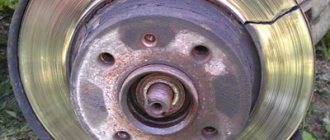Today, all owners of Lada Kalina are interested in the question: why does the electric power steering on Kalina not work?
? After all, this car began to be produced back in November 2004, with electric power steering as standard. The ten-year anniversary has passed, but according to reviews from car enthusiasts, this problem still exists.
The electric amplifier consists of an electric motor, a force transmission mechanism and an electronic control system. The operation of the electric booster is controlled by an electronic unit with three special sensors, which must quickly determine the speed of the car, engine speed and the required force to turn the front wheels.
When starting the engine with the starter, the electric power steering (EPS) does not work. It turns on only when reaching 400 rpm
crankshaft and stops working when the car accelerates over 60 km. at one o'clock.
Symptoms of a problem
It is impossible to immediately understand why the electric power steering does not work on Kalina. However, in most cases of malfunction (EUR), a light indicating a steering wheel with an exclamation mark should light up on the instrument panel. After which, specialists from the VAZ automobile plant recommend driving at low speed to a car service center.
Why at low speed? Because in the first years of production (EUR) by the Makhachkala plant, it had the peculiarity of turning the drive wheels of the car as far as possible to the left or right and independently locking itself in this position.
There is no need to talk about the consequences
.
But even if the emergency light on the dashboard does not light up, the steering wheel may begin to crack and shake violently, or you will feel that the power steering switches off and on on its own from time to time, for no apparent reason at all. The electric motor and mechanical part (EUR) rarely cause complaints, but the electrics and electronics require a detailed study of breakdowns.
Debriefing
The electronic control unit (ECU) for the electric power steering
is fixed in the wrong place, under the heater radiator
. Any leakage of this part causes the ECU to get wet, after which you will feel that the power steering is not working and the steering wheel has become heavy.
If while driving you notice that the tachometer or speedometer needle is at zero and does not move, rest assured that the ESD of your car is not working. This happens because these devices and (EUR) are activated from the same sensors.
Most often on Kalina, . Buying a new sensor and replacing it solves this problem. There are very often cases when replacing sensors does not help, (the electric power steering) still does not work. Begin to methodically probe the entire chain of wires related to the system (EUR).
And the connecting plugs and blocks are of poor quality and break electrical circuits on their own at the most inopportune moment.
Kalina's power steering
behaves poorly when the on-board voltage drops
. If it produces less than 30 volts instead of 15, then the electronic control unit of the power steering may also refuse to work.
One of the new products of the Russian automobile industry, the Lada Kalina, became the first domestic car equipped with EMURU - electromechanical power steering. How does Kalina electric power steering work? A separate large article will be devoted to the answer to this question. We will only note that as the speed the car picks up increases, the compensating torque of the electric power steering gradually decreases, and when it reaches 60 km/h it turns off automatically. At first, this part was not completely “finished” and had one dangerous property - it could turn off while the car was moving, regardless of its speed limit. It should be noted that today all these problems are a thing of the past. Let us add that the electric amplifier can be completely turned off by removing one of its fuses. True, the steering will become even “heavier” than on the “ten” or “fourteenth”.
The EMURU device operates from the vehicle’s on-board electrical network with a voltage of 10.8 to 15V.
Location of contacts on the blocks
Block X1: 1. “Plus” from the battery (12V); 2. “Minus” from the battery. Block X2: 1. Ignition switch (“plus” from the terminal); 2. Signal input (tachometer); 3. Signal input (speed sensor); 4. Output (EMURU status indicator); 5. K-line output (diagnostic block); 6. L-line output (free); 7. General (mass); 8. Technological output (free). Block X3: motor phases: A. (1 and 2) – phase A; B. (1 and 2) – B; C. (1 and 2) – C. Block X4: torque sensor ESD “Kalina”: 1. Common wire 1; 2. General 2; 3. Power contact; 4. Output 1; 5. Output 2; 6. Frequency signal input terminal. Block X5: rotor position sensor: 1. General; 2. Phase A output; 3. Phase B output; 4. Phase C output; 5. Power (+ 5V). The electromechanical power steering installed on the Kalina can operate in the following modes: Self-test Compensation Failure Ready
Error codes for EMURU "Lada Kalina"
So, we have studied the general circuit of the Lada Kalina electric power steering; now we will consider possible digital error codes and briefly describe their meaning. Note that equipment can be diagnosed using a DST-2M scanner with an installed VAZ-IZH cartridge or MT-10 software.
C1000 - no error detected. C1011 – no signal (engine speed circuit). C1012 – no signal (speed sensor circuit). C1013 – the voltage in the on-board network has dropped. C1014 – the voltage at the ignition switch has dropped. Torque sensor: C1021 – voltage (main output). C1022 – voltage (control pin). C1023 – incorrect output signal. C1024 – no signal. Steering shaft position sensor: C1031 – circuit malfunction (main signal). C1032 – circuit malfunction (control signal). C1033 – lack of power. Engine rotor position sensor: C1041 – phase A circuit – malfunction. C1042 – phase B circuit – malfunction. C1043 – phase C circuit – malfunction. C1044 – incorrect sequence. C1045 – lack of power. Power circuits: C1050 – short to ground. Motor, overcurrent: C1051 – phase winding A. C1052 – B. C1053 – C. Break of phase windings: C1054 – break of windings. C1055 – winding A. C1056 – B. C1057 – C. Closing of phase windings: C1058 – closing of windings. S1059 – phase winding A. S1060 – B. S1061 – C. S1070 – unidentified. ECU - electronic control unit: C1071 - RAM error. C1072 – ROM error. C1073 – EEPROM error. S1074 – block relay. C1075 - the radiator temperature is exceeded. C1076 – ECU supply voltage. C1077 – voltage for power capacitors. C1078 – capacitor charging time. C1079 – excess current in one of the windings. C1080 – breakdown of the power transistor. Currently, DST-2M scanners are no longer produced; their place has been taken by more modern and advanced devices of the DST-12 model. With this equipment, you can diagnose not only faults in the Lada Kalina electric power steering. The DST-12 scanner is universal; it is used to service many cars - both those manufactured by AvtoVAZ and models from other manufacturers.
What a driver needs to know about EMUR
Electric power steering on Kalina serves to increase driver comfort. With its help, you can easily turn the steering wheel with one finger, even in a stationary car. This is convenient and practical, since parking with such a system turns out to be much easier and safer. The electric amplifier device includes:
- brushless electric motor;
- gearbox;
- Control block.
The electric motor is located under the steering wheel. A worm is installed on its shaft, which meshes with a plastic gear. The electronic unit controls the operation of the entire system using data that provides:
- torque sensor;
- speed sensor;
- crankshaft speed sensor.
After collecting data, the control unit regulates the supply voltage that is supplied to the electric motor. The lower the vehicle speed, the more voltage is supplied to the electric motor.
The lamp indicating a malfunction of the electric booster on Kalina lights up as soon as the ignition is turned on. After starting the engine it goes out. This is normal operation of the system, but if it breaks down, even after starting the engine, the lamp continues to light.
Reasons for failure of the electric amplifier.
- There is no signal from the speed sensor.
- Critically low voltage in the on-board network.
- The permissible engine speed has been exceeded.
- Control unit malfunction.
To repair the power steering, the steering wheel and part of the torpedo are removed
In the first three cases, failure of the EUR on Kalina can be eliminated quite simply. You need to either tighten the alternator belt or apply less force when pressing the accelerator pedal.
A malfunction of the control unit is a reason to visit a diagnostician who will conduct a quality inspection and identify the breakdown. Moreover, some problems can be fixed by an electrician, but some turn out to be fatal, and only replacing the entire unit will help.
Today, all Lada Kalina owners are interested in the question: why does the electric power steering on the Kalina not work? After all, this car began to be produced back in November 2004, with electric power steering as standard. The ten-year anniversary has passed, but according to reviews from car enthusiasts, this problem still exists.
The electric amplifier consists of an electric motor, a force transmission mechanism and an electronic control system. The operation of the electric booster is controlled by an electronic unit with three special sensors, which must quickly determine the speed of the car, engine speed and the required force to turn the front wheels.
When starting the engine with the starter, the electric power steering (EPS) does not work. It turns on only when reaching 400 rpm
crankshaft and stops working when the car accelerates over 60 km. at one o'clock.
Diagnostics of EMURU without a scanner
In the absence of a scanning device, fault codes for the electric power steering can be read using the “paperclip” method. To do this, you will need to perform the following steps: 1. Turn off the ignition; 2. Close contacts No. 6 and 7 at the 8-pin connector of the control unit (control unit), which is located next to the power connector. 3. Turn on the ignition. You will be able to “read” the codes by the flashing diagnostic light. Which contacts need to be closed? Look at the control unit connector from the wire side (we remind you that it is 8-pin, black). We consider the first contact to be the one located at the top right and count from right to left: 1. Ignition switch (+12V) – blue. 2. Tachometer – red-brown. 3. Car speed – gray. 4. EMURU control lamp – white and pink. 5. K-line – black and yellow. 6. L-line – empty contact. 7. Mass – brown. 8. Empty contact. If you are planning to independently repair the Lada Kalina electric power steering, you need to remember, or better yet, write down the following data: Light code parameters (temporary): 1. Initial pause - duration 2 seconds; 2. Long signal – 2 seconds; 3. Short signal – 0.5 sec; 4. Pause between signals – 0.5 seconds; 5. Pause between codes – 2 seconds. Decoding the light code of faults: 1. “11” - the system is working; 2. “12” - there is no engine speed signal; 3. “13” - torque sensor; 4. “14” - EMUR engine; 5. “15” — sensor PRV (steering shaft position); 6. “16”—PRD sensor (engine rotor position); 7. “17” — on-board network; 8. “18” - control unit; 9. “19” - vehicle speed sensor. That's all the basic information you need to know on this issue. We hope that you understand - if the electric power steering of the Lada Kalina does not work, there is no need to panic and run to a car repair shop; repairing the device is quite possible even for a non-professional. We are confident that this information will provide you with significant assistance in operating and maintaining your vehicle.
Electric power steering, or simply EPS, replaces its common opponent, namely the hydraulic power steering (power steering). This is facilitated by the development of technology, the development of electronics, as well as the installation of advanced driver assistance systems (for example, automatic parking). Also, its electric counterpart allows you to save a little fuel. Now there are at least 4 main designs of this type. BUT! Many manufacturers are in no hurry to switch from “hydro” to “electric”. But why? Is it as ideal as it works? How does the EUR work? How should it be operated so as not to be ruined? We’ll talk to you about this today, as usual there will be a video version. So let's read and watch...
First, a little definition.
EPS (electric power steering)
– an electromechanical system that allows you to reduce the control force applied to the steering wheel.
At the very beginning, I would like to say that this article will not be about comparison; I already have such an article (although some points will still slip through).
Lights indicating a malfunction
Now let's look at the indicators that indicate problems.
| The red battery symbol lights up on the control panel if there is no battery charge from the generator unit. In the case of hybrid cars, the appearance of such a light will be accompanied by the inscription Main. |
| A lamp in the form of an oil can informs the driver that there is a lack of motor fluid in the power unit. The symbol always appears when the ignition is activated and disappears after the engine is started. If the indicator lights up after starting the internal combustion engine, then you need to check the oil level in the engine, all leaks must be eliminated. |
| Malfunction of the airbags. You need airbags; if an emergency or collision occurs, then most likely the airbags will not deploy. |
| This symbol can be made in different variations. If the color of its glow is red, then there are malfunctions in the functioning of the brake system, so the system must be checked before driving. The lamp may come on as a result of a lack of brake fluid in the reservoir or worn out pads. It is possible that the reason for the appearance of the lamp is due to a sensor failure. |
| The on-board computer detected malfunctions in the functioning of the ABS. If there is ice on the roads, then the problems must be corrected, since such driving can be very dangerous. The brake will function, but the ABS system will not work. |
| The Check Engine light comes on when the electronic control unit detects a malfunction in the operation of the power unit. There can be a huge number of reasons in this case, so you need to do computer diagnostics. |
| Faulty glow plugs - this symbol is only available in diesel vehicles. If the light is constantly on, you need to check the ignition system. |
If you are faced with a problem with the dashboard not working, then the video below will allow you to familiarize yourself with the repair process using the example of a Volkswagen car (the video was filmed by the altevaa TV channel).
Hi all! Today I want to raise a rather current topic that, judging by the questions on the forums and the number of requests in search engines, worries a large number of people. I want to talk about a phenomenon where when you press the brake pedal, an exclamation mark on the dashboard lights up.
I will try to give a comprehensive answer to this question and explain why this happens and what kind of damage may be involved. Go!
Let me start, perhaps, with the fact that if a lamp (!) lights up on the panel, it means something is wrong with the brake system. As a rule, this indicator signals a low level of brake fluid (BF) in the system. As you can imagine, faulty brakes are no joke and the problem needs to be addressed. I’ll say more, if anyone doesn’t know, OPERATING A CAR WITH A BURNING INDICATOR (!) IS PROHIBITED!
Since you don’t know what’s wrong and what caused this error to appear on the dashboard.
About EGUR
Another useful information and again at the beginning of the article, many people confuse the electric power steering with the so-called electric power steering - electric power steering. But this is extremely wrong. EPS is simply an improved hydraulic booster, the only difference is that a regular power steering uses a belt drive from the engine crankshaft, which spins the pump to pump up pressure in the system, that is, a mechanical transmission. The electric power steering does not have such a transmission, it is not connected to the crankshaft at all, it simply has an electric motor on top, which is powered by the on-board system and builds up pressure.
Essentially, the belt and mechanical pump were replaced with wires and an electric pump, hence the prefix “E” - electric.
What to do if the lamp comes on?
- The first thing you need to do is check the fuel fluid level. This is done simply and without any difficulties. Open the hood and look at the level, it should be between o and “MAX”. The level must be monitored constantly; for those who forget to do this, there is an exclamation mark. It lights up based on a signal from the sensor, which signals when the fuel level is below the permissible level.
By the way! There are often cases when the light comes on when driving over uneven surfaces and goes out as soon as the car drives onto a more or less level road. This happens precisely for the reason that the level of “brake fluid” is close to o and when the car is rocking, the sensor detects a low level and signals this to the instrument panel.
- If everything is in order with the brake fluid level, you need to check the fuel injection system, which is located in the brake fluid tank. I'll tell you how to do this now.
2.1. Turn on the ignition and make sure that the exclamation mark lamp comes on, that is, the indicator of insufficient fuel level. It should light up and go out if the level is normal and the sensor is working.
2.2. We turn off the power from the sensor and look at the lamp; if it goes out, most likely there is a problem with the sensor. Check the sensor, sometimes the problem is that the float fails and sinks to the bottom even though the fuel fluid level is fine.
2.3. If, after turning off the power from the sensor, the exclamation mark on the panel continues to light, most likely the problem is in the wiring, and the sensor itself is working. Perhaps the reason is a short circuit in the wiring, or something else, but one way or another the problem will be associated with a faulty wiring and a violation of its integrity.
If everything is fine with your fuel oil level sensor, but you want to check its operation, this is done quite simply
2.4. We press the rubber seal on the tank lid, so you lower the sensor float to the bottom, and in working sensors an exclamation mark on the panel lights up.
2.5. If the indicator does not light up, take a small piece of copper wire and turn off the power from the brake fluid level sensor. The prepared wire must be used to close the power contacts of the sensor, that is, the contacts on the wiring that is supplied to the sensor, and not the contacts of the sensor itself. With such a short circuit, a corresponding signal about low brake fluid level should appear on the panel. If this does not happen, most likely the sensor is working, and the problem is faulty wiring.
If the brake fluid level sensor is faulty, replace it; if the problem is in the float of this sensor, you can try to repair it; if the wiring is faulty, replace it or seek help from an experienced auto electrician.
How does electric power steering work?
There is no oil or any other liquid here; in fact, it is an ordinary steering rack (without any amplifier at all) to which an electric motor is installed on one or another shaft, which acts as an amplifier. There are different designs:
- When installed on the steering shaft, that is, placed inside the car and strengthens the driver's shaft, directly from the steering wheel
- When the engine is mounted on the rack shaft and strengthens it
The main parts (I won’t take the rack and steering shaft itself, everything about them is already clear)
- Electric motor. Modern brushless
- Servo. It also differs by type, more on that below.
- Torque sensor. The main sensor of the system is usually installed on the torsion bar, which is placed in a section of the steering shaft. There are two different parts of the sensor located at the ends of the torsion bar. It can be either optical or magnetic.
- Steering sensor
- Control block
- OPTIONAL – a steering speed sensor can be installed
When the steering wheel turns, the torsion bar begins to twist; the more we turn the steering wheel, the more it twists. The applied force is estimated by the magnitude of changes in parts of the sensor position.
Another measurement is made by the steering angle sensor; it “sees” how much the steering wheel has deviated. Both of these readings are sent to the EURA control unit, and it already interacts with. The ECU also receives the following important parameters:
- Vehicle speed, from ABS sensors
- Engine speed from engine sensor
After this, based on all the data, the ECU calculates the required force (assistance) on the steering wheel, and supplies the electric motor with power of the required polarity and magnitude. The electric motor itself begins to rotate either the steering shaft or move the shaft of the rack itself.
Main types of EURA design
- Built into the steering shaft (column).
If we consider the rack itself, then it is a regular steering rack, without any changes. The engine itself is located in the cabin and is located on a shaft built into the steering column; this is the cheapest design of all electric types. That’s why it is so widely installed on budget car models, including many VAZs. The positive aspects are not only the price and the simple design of the rack, but also the fact that the electrical part is located in the cabin, which means it is less susceptible to temperature changes and moisture (snow) from under the wheels, that is, survivability is increased. The disadvantages are that the system is equipped with a worm joint, because of this, friction losses increase, and the information content of the steering wheel decreases. That is, inertia + friction, it is impossible to adjust the sensors! This “catches the eye,” especially for those drivers who switched from power steering.
Positive aspects and possibilities of use
There are quite a lot of advantages of electric power steering; it seems to me that soon almost all manufacturers will switch to this type, completely abandoning hydraulics. And now point by point:
- Economical. The electric booster allows you to save from 0.5 to 0.8 liters per 100 km. It is not connected to the engine by a rigid belt, and therefore does not take power from it, but consumes it only when needed. For example, at idle speed it does not work at all, while the power steering is constantly connected to the crankshaft.
- Reliability. Here it is higher, especially if the electric motor is located inside the car. There are no hoses, no fluids, no other parts.
- Service. It's practically not needed here! No need to change after a certain mileage to restore functionality.
- Silence of work. If the power steering catches air, then this is unlikely to happen with the power steering. YES, and a working unit is much quieter.
- Node cost. If we take it as a whole, especially the first type, then it is lower than that of its hydraulic counterpart, but the repair is often much higher, because the sensors or entire elements are changed.
- Programmable operation. If you can’t simply turn off the power steering, then this can easily happen with the power steering, and it can be programmed. For example, at low speeds we need a lot of effort on the steering wheel, but when picking up speed we don’t need much effort, in fact the steering wheel is already well controlled. This is where the electrical amplifier can also be switched off by software, again saving fuel. YES, and many cars have a forced shutdown switch, this is again a plus.
If you take the possibilities that it gives, they are almost limitless. Systems such as vehicle stabilization when sharply avoiding obstacles, lane keeping, and parking assistance are already in operation. It should be noted that the ESD is a step towards automatically piloted vehicles.
Negative points
They also exist and, in principle, I listed them in this article, but now I’ll repeat myself a little:
- Inferior information content of the steering wheel (hydraulics, more precisely for now)
- Electrical failures in settings. The sensor (steering wheel or shaft) may go off and, for example, when parking, turn the wheels to the side, when you should keep them straight. Moreover, it is quite difficult to align the wheels.
- Traffic disruptions. IN early versions there were accidents due to blocking or glitches of the EURA
- Electrical component. As a rule, it is not repaired, but often changed, BECAUSE YOUR SAFETY DEPENDS ON IT. That is, you should not “re-solder” the steering wheel or shaft position sensor, because you can enter incorrect parameters into the circuit. It's better to change it. The engine is also completely replaced when it fails, which is not cheap.
- Repairs are not always needed. Often, due to high mileage or clogging, you simply need to calibrate the sensors; you cannot do this yourself; again, you need to go to a service station. And if it is not clean, they may charge you for repairs.
Rack-and-pinion steering with electric power steering is UNDOUBTEDLY THE FUTURE, but there are still many crude types that power steering is superior to in many ways.
Let's watch an educational video.
This is where I end, I think my material was useful to you. Sincerely yours, AUTOBLOGGER.
The car of our time is radically different from the cars of the last century. This applies to all aspects. And one of the main features of the new car was the ease of rotation of the steering wheel. Now, even while in a stationary car, the driver can turn the steering wheel with two fingers. How is this effect achieved? This is the work of electric power steering (EPS). But sometimes it fails.
Electric power steering
This device increases the force that is transmitted in the steering system. Simply put, you can turn the steering wheel with two fingers. Previously, VAZ models were equipped with hydraulic boosters (power steering), but starting with the Lada Kalina they were abandoned.
The EUR was developed. In terms of force transmission power, power steering is preferable, however, it has many disadvantages:
- Engine power take-off.
- Constant monitoring of the level in the tank is necessary.
- Checking oil lines.
The electric amplifier is devoid of all these disadvantages. And it is even easier to repair than power steering. But it also has its own faults.
EUR device
Main components of an electric amplifier:
- Mechanical part.
- Electrical component.
- Electronic control unit (ECU) with peripherals.
The mechanical part includes the actual steering parts, connecting parts and mounting hardware. That is, the input and output shafts, bracket, nuts, bolts, studs and springs. Well, there’s also an adjustment lever for changing the angle of the steering wheel.
Electric, actually the amplifier motor itself. The most vulnerable is the electronic component. ECU and connectors with sensors.
Debriefing
The electronic control unit (ECU) for the electric power steering is mounted in a bad place, under the heater radiator
. Any leakage of this part causes the ECU to get wet, after which you will feel that the power steering is not working and the steering wheel has become heavy.
If while driving you notice that the tachometer or speedometer needle is at zero and does not move, rest assured that the ESD of your car is not working. This happens because these devices and (EUR) are activated from the same sensors.
Most often on Kalina, the speed sensor fails. Buying a new sensor and replacing it solves this problem. There are very often cases when replacing sensors does not help, (the electric power steering) still does not work. Begin to methodically probe the entire chain of wires related to the system (EUR).
Due to the constant vibration of the car and poor quality of production, connecting plugs and blocks independently break electrical circuits at the most inopportune moment.
Kalina's power steering behaves poorly during on-board voltage fluctuations
. If an old generator produces less than 30 volts instead of 15 volts, then the electronic control unit of the power steering may also refuse to work.
Methods for determining EUR malfunction
Well, of course, the first sign of a breakdown in the system is the activation of the ECU warning light on the instrument panel. Usually on a standard one, this is an icon in the shape of a steering wheel with an exclamation mark. When you turn on the ignition, it lights up for a few seconds, and then, if the computer decides that everything is in order, the light goes out. And accordingly, when a breakdown of the Priora’s electric amplifier is detected, it lights up and remains on.
Important! It must be remembered that the Priora's electric amplifier is connected by its computer to the on-board ECU of the VAZ 2170 Priora, and therefore the best thing to do is to do computer diagnostics. Nowadays, individual diagnostic scanners are sold, which are available to any Priora owner, not only in terms of price, which is around 1,250 rubles, but also in terms of ease of use.
So, carry out computer diagnostics, contact the ECU, get error codes with or without decoding. Even if the scanner only produces codes, it’s not scary. You can just know that faults associated with the Priora ESD begin with the symbol “C”. For example, C1013, means that the voltage in the network is low, and this is not enough for the electric amplifier.
Well, there may be several options. The most common case is the weakening or burning of one of the two power wires going to the EUR. These are red and black wires, large cross-section, included in a separate connector on the device. They are quite easy to check. It could also be a large fuse for the device, everything is clear here. Well, the third reason is a deficiency in the car’s network, for example, a weak or faulty battery or generator. In case of such a malfunction, contact a specialist, and nothing else. To an auto electrician.
“Folk” method of checking a malfunction, or “control”
Well, if the indicator does not light up, and there are doubts about the serviceability or malfunctions of the Priora ESD, or after repairs you need to do a “check,” proceed as follows: you need to turn the steering wheel without turning on the ignition. Remember the effort. And repeat the operation by starting the engine. If there are no changes, something happened to the Priora EUR!
What malfunctions exist in the Priora electric booster?
And again the same list, mechanics, electrical, electronics. Well, everything is clear with mechanics, this is a failure of shafts, connections and fittings. With this malfunction, the wheels simply will not respond to the steering wheel turning. And this problem is easiest to fix. But with other faults it is much more complicated. If the malfunctions are related to the failure of the servomotor, amplifier, or Priora itself, there is no point in thinking about repairs. It’s easier to buy a new EUR at the store and replace it yourself. Or take it to a service center and try to repair it there. If the connection with the Priora ESD ECU is lost, then this is most likely the second connector, with a trail of wires, the same is true if the unit does not receive a signal from external sensors - the crankshaft and camshaft. Yes, yes, they are also important for the operation of the device. In these cases, an inexpensive bundle of wires can be removed and repaired, or replaced.
What remains is the “brain” of the electric amplifier, and the internal position sensors of the unit’s shafts. Messing with sensors is not an option, only repair service. But the computer itself, if it malfunctions, you can buy and replace yourself.
Removal and installation of the electronic power steering control unit on the Lada Kalina
For this repair you will need a Phillips screwdriver, the whole job will take at least half an hour, as you will have to. After you have “got rid of it”, you can move on.
- First, unscrew the three bolts securing the plastic trim below the panel:
- After it is removed, the control unit becomes accessible, as shown in the photo below:
- The next step is to disconnect all the plugs and wires, out of three. They are attached as usual using latches and are very easy to remove.
- Now you can unscrew the two mounting bolts with a Phillips screwdriver, which are shown in the photo below:
- After this, we take it by the upper part and lower the electric power steering control unit down, since it is still attached to the plate. It lowers simply, just apply a little effort and it will be almost at the very pedals, it is clearly shown below:
- And there is very little left to do - unscrew the three bolts securing the power steering unit from the plate on which it is installed:
- And holding it from below, we take it out freely. For reference, my 2011 Kalina has a used unit made in Korea. And thank God it’s not ours, the quality of the Korean assembly will be better than that of our craftsmen. At least, I never had any problems with the electric booster in 2.5 years of use.
If replacement is required, install the new module in the reverse order of removal. But it is advisable that you do not have to change this element in the electronics on Kalina, which is quite expensive, around 5,500 rubles according to some official online stores.
One of the most problematic areas of the Lada Priora is the electric power steering. That is why repairing electric power steering is a common problem faced by Priora owners. If you find that the EUR on the Priora does not work, then immediately contact a specialist or do the repairs yourself. Most often, the electric power steering of the Priora has two causes of malfunction.
Interesting fact! Electric power steering was invented and introduced into cars back in 1990 in Japan at the factories of the Toyota automobile concern.
How to determine that the EUR needs repair
The electric booster on the Priora does not work very often. It refuses to work on both new and used cars.
If a problem occurs with the electric power steering, a yellow button on the dashboard lights up, with a steering wheel with an exclamation mark on it.
This button notifies you of malfunctions or failure of the electric power steering.
You can drive the car without the help of an electric booster.
To do this, you just need to pull out the power steering fuse, which is located to the left of the steering wheel. Malfunctions of the EUR on a Priora should not scare you, since this malfunction can be eliminated even on your own.
Main malfunctions of electric power steering and their causes
The electric power steering on a Priora fails for the following reasons:
1.When the ignition is turned on, the ESD does not undergo self-monitoring and turns itself off so as not to interfere with the driver and not create an emergency situation on the road. In this case, repairs will be expensive.
2. The electric power steering on the Priora does not work due to a malfunction of the speed sensor. The EUR scans the vehicle's speed from the speedometer, which receives data from the speed sensor. When a sensor breaks down, it begins to provide incorrect information. Then the EUR turns off spontaneously, since it does not know the exact speed of the car. In this case, repair of the electric amplifier is carried out by replacing the sensor.
If the electric power steering on a Priora does not work, a flashing error on the dashboard will immediately let you know.
How to repair the EUR yourself
The electric power steering of the Priora has several causes of malfunction and one way to solve them. For repair you will need:
- Head for 8 and 13 mm
- Ratchet or crank
- Extension
- Hammer
- Chisel
